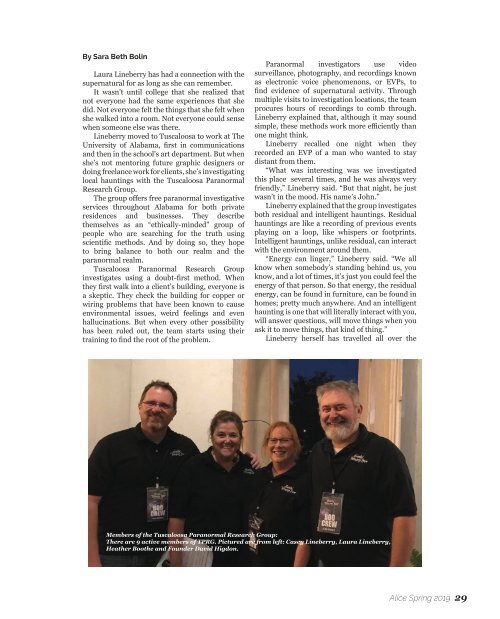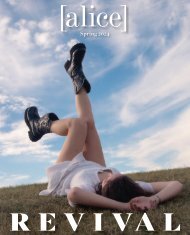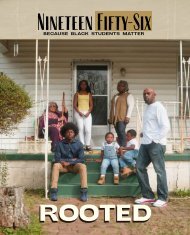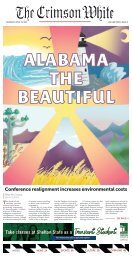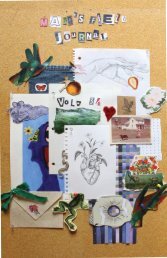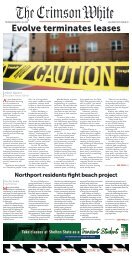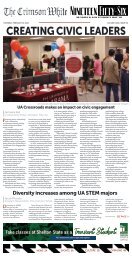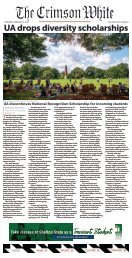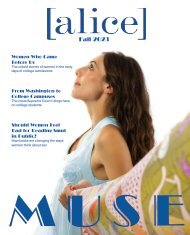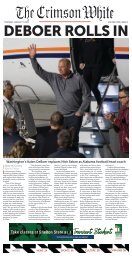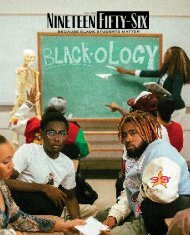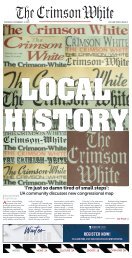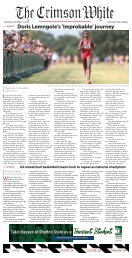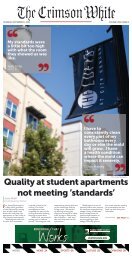Alice Vol. 4 No. 2
Published by UA Student Media Spring 2019.
Published by UA Student Media Spring 2019.
Create successful ePaper yourself
Turn your PDF publications into a flip-book with our unique Google optimized e-Paper software.
By Sara Beth Bolin<br />
Laura Lineberry has had a connection with the<br />
supernatural for as long as she can remember.<br />
It wasn’t until college that she realized that<br />
not everyone had the same experiences that she<br />
did. <strong>No</strong>t everyone felt the things that she felt when<br />
she walked into a room. <strong>No</strong>t everyone could sense<br />
when someone else was there.<br />
Lineberry moved to Tuscaloosa to work at The<br />
University of Alabama, first in communications<br />
and then in the school’s art department. But when<br />
she’s not mentoring future graphic designers or<br />
doing freelance work for clients, she’s investigating<br />
local hauntings with the Tuscaloosa Paranormal<br />
Research Group.<br />
The group offers free paranormal investigative<br />
services throughout Alabama for both private<br />
residences and businesses. They describe<br />
themselves as an “ethically-minded” group of<br />
people who are searching for the truth using<br />
scientific methods. And by doing so, they hope<br />
to bring balance to both our realm and the<br />
paranormal realm.<br />
Tuscaloosa Paranormal Research Group<br />
investigates using a doubt-first method. When<br />
they first walk into a client’s building, everyone is<br />
a skeptic. They check the building for copper or<br />
wiring problems that have been known to cause<br />
environmental issues, weird feelings and even<br />
hallucinations. But when every other possibility<br />
has been ruled out, the team starts using their<br />
training to find the root of the problem.<br />
Paranormal investigators use video<br />
surveillance, photography, and recordings known<br />
as electronic voice phenomenons, or EVPs, to<br />
find evidence of supernatural activity. Through<br />
multiple visits to investigation locations, the team<br />
procures hours of recordings to comb through.<br />
Lineberry explained that, although it may sound<br />
simple, these methods work more efficiently than<br />
one might think.<br />
Lineberry recalled one night when they<br />
recorded an EVP of a man who wanted to stay<br />
distant from them.<br />
“What was interesting was we investigated<br />
this place several times, and he was always very<br />
friendly,” Lineberry said. “But that night, he just<br />
wasn’t in the mood. His name’s John.”<br />
Lineberry explained that the group investigates<br />
both residual and intelligent hauntings. Residual<br />
hauntings are like a recording of previous events<br />
playing on a loop, like whispers or footprints.<br />
Intelligent hauntings, unlike residual, can interact<br />
with the environment around them.<br />
“Energy can linger,” Lineberry said. “We all<br />
know when somebody’s standing behind us, you<br />
know, and a lot of times, it’s just you could feel the<br />
energy of that person. So that energy, the residual<br />
energy, can be found in furniture, can be found in<br />
homes; pretty much anywhere. And an intelligent<br />
haunting is one that will literally interact with you,<br />
will answer questions, will move things when you<br />
ask it to move things, that kind of thing.”<br />
Lineberry herself has travelled all over the<br />
Members of the Tuscaloosa Paranormal Research Group:<br />
There are 9 active members of TPRG. Pictured are from left: Casey Lineberry, Laura Lineberry,<br />
Heather Boothe and Founder David Higdon.<br />
<strong>Alice</strong> Spring 2019 29


